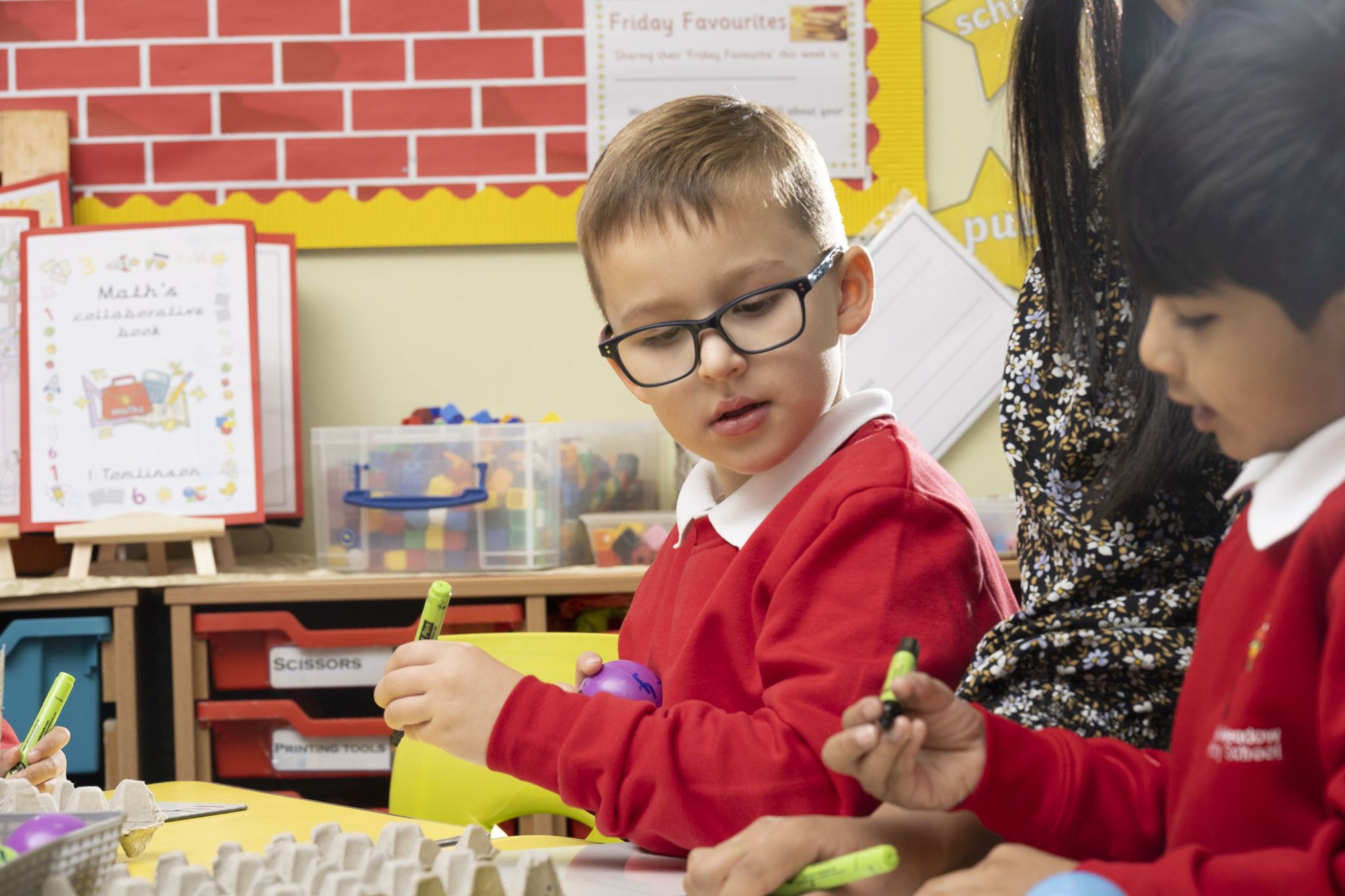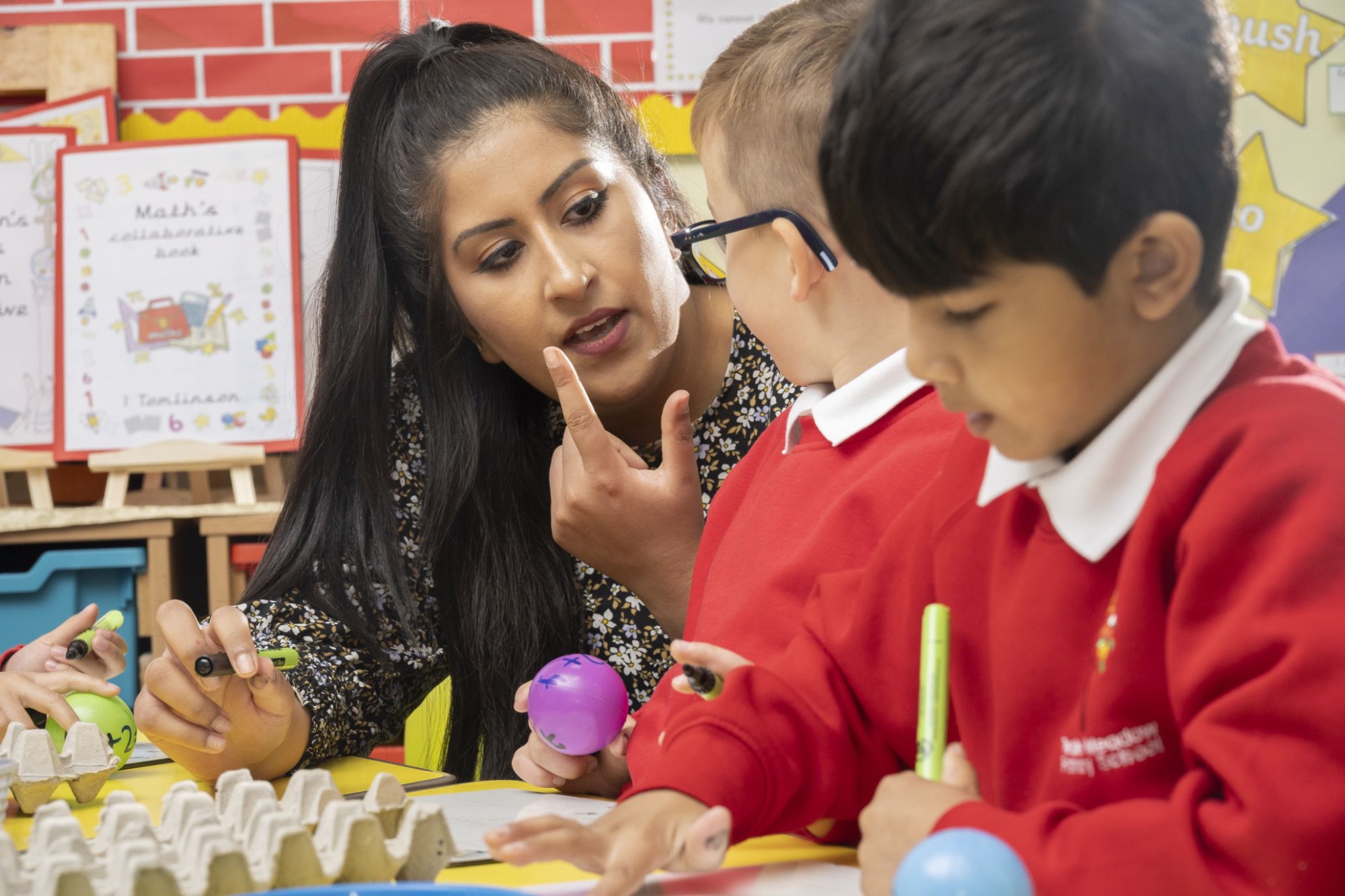Mathematics
Vision and intent for Mathematics
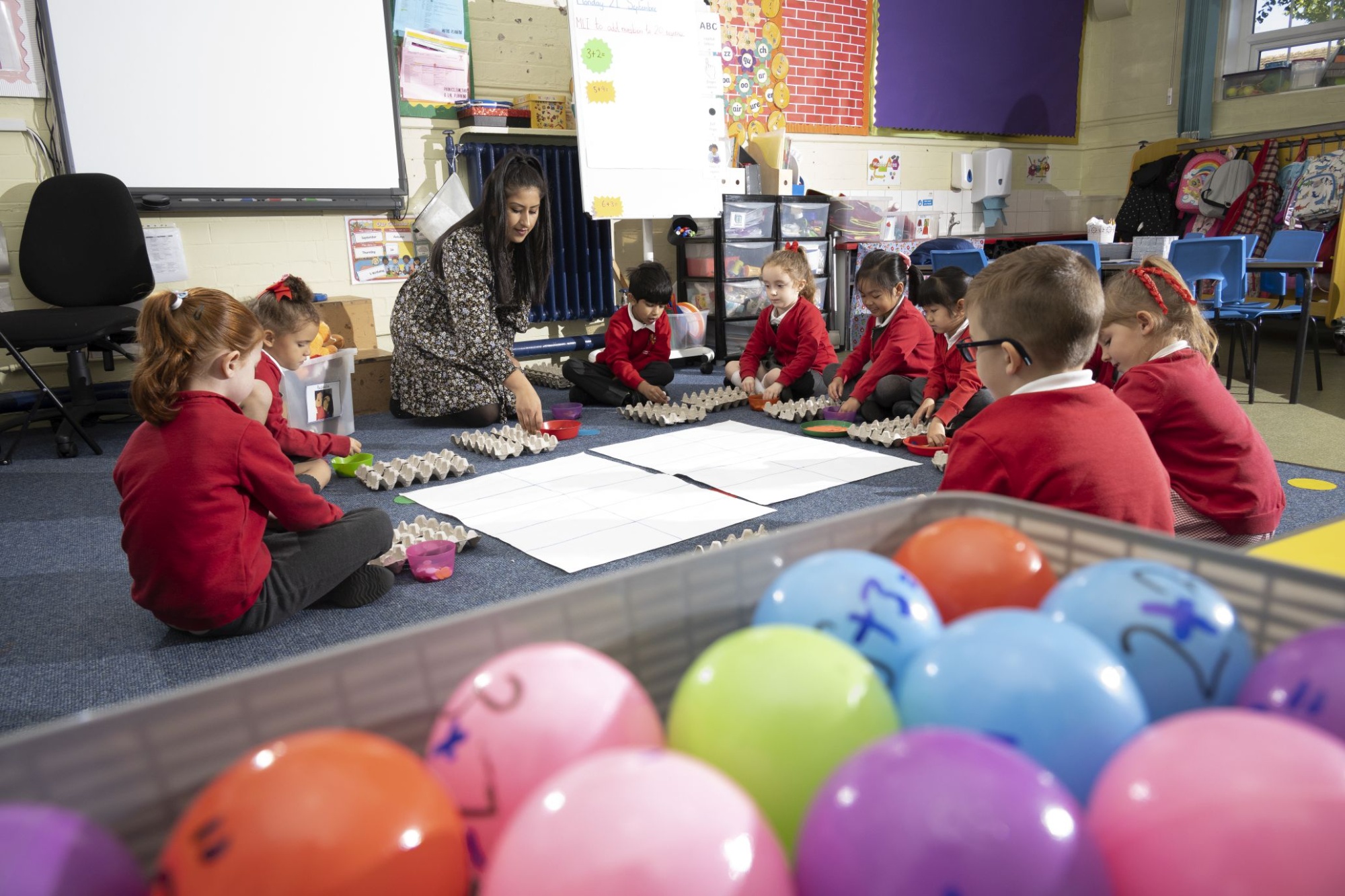

At Temple Meadow, we deliver a high-quality Maths curriculum that gives children the best opportunity to become confident, numerate, successful members of society; we aspire for all children to leave Temple Meadow primary school with secure foundations for future life. We aim for all children to make accelerated progress regardless of their backgrounds and ability and do this through a child centred approach. Our teachers know each learner inside out and build positive relationships where children can achieve their best. Lessons are engaging, practical and relevant.
Cultural capital considerations for Mathematics
Given our context linked to high levels of deprivation, we are aware of the high need to support the development of Temple Meadow pupils’ Maths capital. This is key to their future success in their next stage of education and in future life. We plan to ensure that the experiences we provide through our Maths curriculum and by connecting learning across subjects, gives them confidence and the capacity to succeed in the future and to support a long-term aspiration of all UK pupils achieving in society.
As successful and confident mathematicians, pupils can expect to flourish in STEM job opportunities. STEM careers, include (but are not limited to), teacher, accountant, data analyst, engineer, data scientist, banking associate, scientist etc. Pupils will also benefit from increased confidence when dealing with mathematics in every day life, such as: shopping and timetables for trains and buses etc.
Implementation of Mathematics
Each mathematics unit is taught as a journey through varied fluency, reasoning and problem solving. We follow the White Rose long-term and medium-term plans to ensure all of the curriculum is taught to a high standard. We also use a Singapore Maths approach to our Maths lessons, which enables the children to use practical resources and view problems pictorially. This is a key approach that enables children to access learning and acquire new skills.
At Temple Meadow we have made a conscious decision to choose this product to build a culture of deep understanding and mastery across the mathematics curriculum. This product helps pupils to become confident and competent mathematicians by equipping teachers with the tools and knowledge necessary to deliver a mathematics curriculum with passion and with high expectations. This product provides a vast bank of clear, practical resources and bespoke CPD to help raise standards.
Although we have made a conscious decision to use White Rose as a product, we have created our own curriculum overview for Maths. Teachers will use this curriculum overview to deliver the majority of the units outlined within each unit, using White Rose as a supporting resource (example of the curriculum overview is below). As teachers follow the learning journey, pupils will experience mathematics through the CPA and Singapore Maths approach. This ensures that mathematics remains pictorial and enables pupils to use a variety of strategies to solve problems – thus removing barriers and ensuring mathematics is accessible to all. The curriculum has been specifically designed to give pupils the time to master each skill. Early mastery of skills is also encouraged, as skills from the following year group have been naturally linked to, which removes the ceiling on learning outcomes.
There are mathematical units that will be taught using a cross-curricular approach. Pupils should expect to be taught statistics and time through other areas of the curriculum, such as Geography and Science. This enables children to see that mathematics is not a stand alone subject and has an impact within other subject areas. This also allows for more time within mathematics lessons to teach other units in greater detail and address any misconceptions or gaps in knowledge.
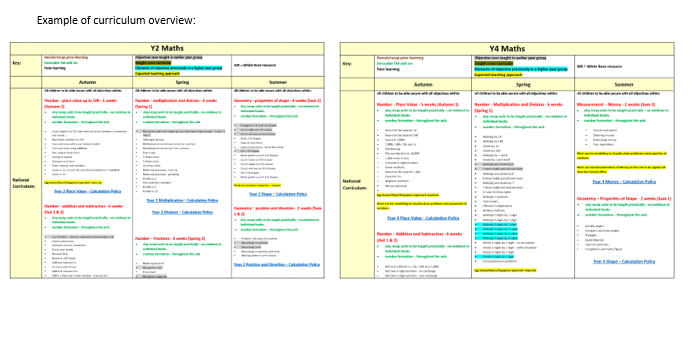

National Curriculum coverage
The purposes of the National Curriculum is to provide pupils with the opportunity to gain, develop and apply a range of mathematical skills; to increase knowledge and confidence and to build skills for life. The mathematics National Curriculum is aspirational and expects children to push knowledge boundaries and encourages pupils to believe that they can be ambitious with their future aspirations
Purpose of study
Mathematics is a creative and highly inter-connected discipline that has been developed over centuries, providing the solution to some of history’s most intriguing problems. It is essential to everyday life, critical to science, technology and engineering, and necessary for financial literacy and most forms of employment. A high-quality mathematics education therefore provides a foundation for understanding the world, the ability to reason mathematically, an appreciation of the beauty and power of mathematics, and a sense of enjoyment and curiosity about the subject.
Aims
The national curriculum for mathematics aims to ensure that all pupils:
- become fluent in the fundamentals of mathematics, including through varied and frequent practice with increasingly complex problems over time, so that pupils develop conceptual understanding and the ability to recall and apply knowledge rapidly and accurately.
- reason mathematically by following a line of enquiry, conjecturing relationships and generalisations, and developing an argument, justification or proof using mathematical language
- can solve problems by applying their mathematics to a variety of routine and nonroutine problems with increasing sophistication, including breaking down problems into a series of simpler steps and persevering in seeking solutions.
Mathematics is an interconnected subject in which pupils need to be able to move fluently between representations of mathematical ideas. The programmes of study are, by necessity, organised into apparently distinct domains, but pupils should make rich connections across mathematical ideas to develop fluency, mathematical reasoning and competence in solving increasingly sophisticated problems. They should also apply their mathematical knowledge to science and other subjects.
The expectation is that the majority of pupils will move through the programmes of study at broadly the same pace. However, decisions about when to progress should always be based on the security of pupils’ understanding and their readiness to progress to the next stage. Pupils who grasp concepts rapidly should be challenged through being offered rich and sophisticated problems before any acceleration through new content. Those who are not sufficiently fluent with earlier material should consolidate their understanding, including through additional practice, before moving on.
At Temple Meadow, this means that children will be set a big problem at the start of each unit, showcasing how many skills in mathematics are combined to solve a problem. Each mathematical unit will take pupils on a journey through varied fluency, reasoning and problem-solving concepts to ensure pupils are mathematically competent across all areas. Throughout each learning journey, pupils can see how the mathematical requirements differ between each strand of learning and how acquired skills can be implemented to be successful. Throughout each mathematical unit, pupils will experience a Singapore Maths approach, which provides a ‘hands-on’ and pictorial representation towards difference concepts. Our Singapore Maths approach to learning is vital in securing early understanding of number and is underpinned by our Calculation Policy which shows clear progression throughout each mathematical unit.
Children will answer knowledge retrievers at the beginning of each lesson to check their mathematical fluency and to check the understanding of previous units. This allows teachers to check retention of previous knowledge and implementation to new problems.
Teacher view of the importance of Mathematics

Timetabling
We currently run 10-day time timetables across Years 1-6. Maths lessons are timetabled daily across days 1-9. In some year groups, Maths is also timetabled on day 10; this is dependent on cohort needs and is adaptable to meet priorities.
Maths is timetabled for between 1 hour, 15 minutes and 1 hour, 30 minutes daily, dependent upon the cohort.
Timestables rehearsal takes place within the timetabled Mathematics lesson.
Multiplication Tables
National curriculum expectation regarding multiplication tables:
At the beginning of each lesson, children will take part in a mental maths warm-up, which will address their recall of multiplication tables.
Children also access Timestable Rockstars, which is an application designed to improve recall of multiplication tables in an engaging way. Children are encouraged to use this at home as regularly as possible and will have experience of this once every half-term in a Maths lesson in school.
The recall and accuracy of multiplications for each child is assessed and monitored using teacher judgements on Learning Ladders and pupil achievements on Timestable Rockstars.
Intent for multiplication tables
The National Curriculum states: ‘By the end of year 4, pupils should have memorised their multiplication tables up to and including the 12-multiplication table and show precision and fluency in their work.’ At Temple Meadow, out aim is to ensure that all children leave primary school confident and competent with all aspects of mathematics, including multiplication tables. This will also provide children with a skill that helps to unlock inter-curricular units, as well as providing pupils with a skill for life.
Implementation for multiplication tables
At the beginning of each lesson, children will take part in a multiplication table learning activity, which will address their recall of multiplication tables. These activities will be games designed to engage all learners and provide children with songs, rhymes and activities to remember tables up to and including 12x12. Teachers will also use knowledge retrievers to check understanding of timetables.
Children access Timestable Rockstars, which is an application designed to improve recall of multiplication tables in an engaging way. Children are encouraged to use this at home as regularly as possible and will have experience of this once every half-term in a Maths lesson in school. The Timestable Rockstars leaderboard in the KS2 Corridor is changed weekly to encourage competition and an increase in speed and accuracy.
Year 3 and Year 4 cohorts will undergo regular multiplication table mock testing, which will enable current standards to be evident and target setting to be completed to enhance standards further.
Impact for multiplication tables
A secure understanding of the multiplication tables not only provides a skill for life, but is the key aspect of unlocking many other principles within the mathematics curriculum. The impact of this will be measured using our internal assessment system and formative assessments.
Fluency, Reasoning and Problem Solving
Fluency, reasoning and problem-solving are stated in the national curriculum as the key aims for showing progress:
Aims
The national curriculum for mathematics aims to ensure that all pupils:
- become fluent in the fundamentals of mathematics, including through varied and frequent practice with increasingly complex problems over time, so that pupils develop conceptual understanding and the ability to recall and apply knowledge rapidly and accurately.
- reason mathematically by following a line of enquiry, conjecturing relationships and generalisations, and developing an argument, justification or proof using mathematical language
- can solve problems by applying their mathematics to a variety of routine and nonroutine problems with increasing sophistication, including breaking down problems into a series of simpler steps and persevering in seeking solutions.
All children will begin each unit by working through the fluency-based skills linked to that specific unit of work. Once complete, the teachers will provide the children with reasoning challenges which require the children to think mathematically and often explain their answers. Finally, children will be required to solve problems linked to the unit they are studying. This requires them to bring together all of their knowledge from fluency and reasoning and think logically about breaking a problem down to find the correct solution.
Concrete, Pictorial and abstract learning
When teaching a new topic, teachers will always consider previous experience. If the topic has not been taught before, then the children will begin using concrete materials. As their confidence and knowledge grows, the children will move onto pictorial representations of problems before finally attempting abstract representations.
Concrete, pictorial and abstract example:
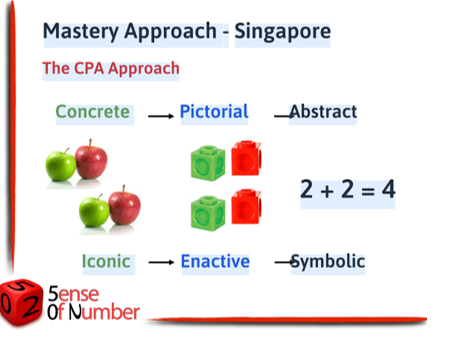
Knowledge retrieval, practise and challenge
Knowledge retrieval
Each child will begin a lesson with a knowledge retrieval. The knowledge retriever will ask children to answer a question linked to prior knowledge/learning. From this, children are regularly revisiting previous units and teachers can judge if knowledge is secure.
Practise
Children will have a new concept modelled to them by the teacher and then practise these skills to a range of questions in their exercise books. Dependent upon the stage of the learning journey, these questions will be fluency, reasoning or problem-solving based.
Challenge
After practising their newly acquired knowledge to a range of questions, the children will then have an opportunity to apply this to a challenge question. This is designed to be a question that a child answers independently by using their new knowledge. For statutory assessment year groups, these challenge questions can be examples of past SATs questions.
Vocabulary
To ensure pupils have high expectations set of them, and the use of vocabulary is consistent throughout school, teaching staff refer to the Calculation Policy for agreed mathematical terminology. The Calculation Policy refers to Singapore Mathematics vocabulary, along with more specialised terminology for more abstract units. Pupils also become familiar with the terms, ‘Varied Fluency’, ‘Reasoning’ and ‘Problem Solving’ within their mathematical journey each academic year.
Pupils will often use collaborative techniques, such as SNAP 2, to talk with another member of the class. When doing so, pupils have the opportunity to rehearse key vocabulary.
Longitudinal study and continuous provision
Our continuous provision approach ensures some aspects of Maths are evidenced within other subject areas. This allows more time in the Mathematics curriculum to masker key concepts. Therefore, units such as statistics are taught within a scientific of geographical lesson.
Abstract concepts, such as time, are delivered continuously throughout the school day. This ensures pupils see time as a real concept and can draw on current experiences. Each classroom is equipped with a 12-hour and 24-hour digital and analogue clock. This allows pupils to see the link between 12-hour and 24-hour representations of time.
Enabling environments and working walls
Teachers use live working walls to display relevant modelling, use of key vocabulary and examples of outcomes. Children are actively encouraged to engage with this resource, when working through a Maths learning journey. Learning walls should have the following headings: Big problem, fluency, reasoning, problem-solving.
Teachers will use the different headings on the learning wall as they enter each phase of the learning journey.
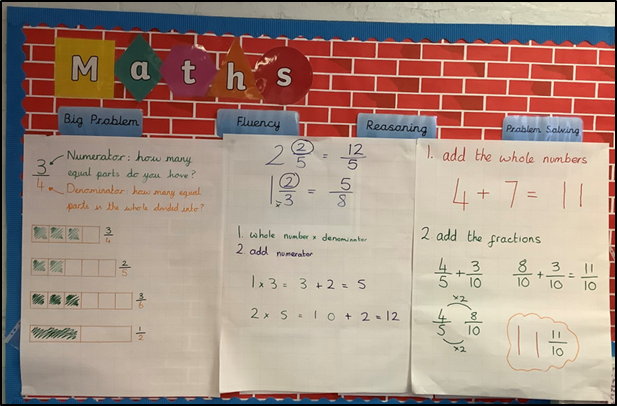
Planning
All planning for Maths is captured on one grid. This is then uploaded to a shared area so all staff can access this if required.
Examples of planning:

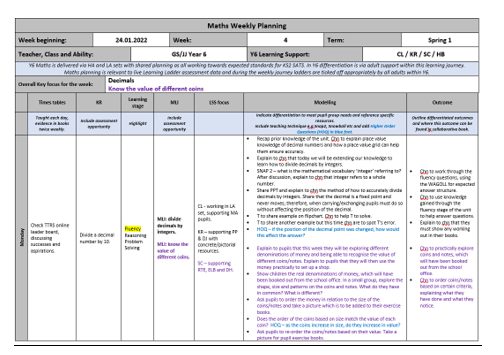
Resources
Each classroom environment has a Maths table-top display, which contains all items that pupils will require in the majority of day-to-day maths lessons. This includes: egg boxes, cubes, dienes, number lines, abaci etc. In order to support teachers, there is a clear resource catalogue set up so that the expected classroom resources can be identified. This resource catalogue also details the resources stored centrally in the resource cupboard, which is for more specialist mathematical units such as measurement.
Example:
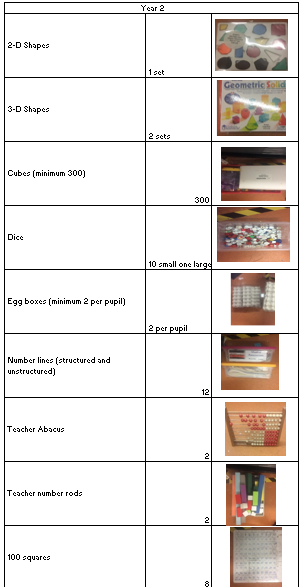
Number formation
A number formation strategy, which will work similarly to that of pen licencing, enables pupils to master this fundamental skill early in their mathematical learning journey. Pupils will practise their number formation within their exercise books, as modelled by the teacher. Once at the expected standards, pupils will receive their award. The display board is located in the KS1 building and will be updated regularly to celebrate those children achieving expectations consistently when forming numbers.

Inclusion
Inclusion is vital across the curriculum but particularly through our Maths curriculum. Children are taught Maths in sets, as this allows children to move at a pace that is appropriate for their learning. We have high expectations of all children to achieve their very best, at their own pace and learning level. Teachers must skilfully differentiate access to mathematical concepts and consider the scaffolding required for each pupil to achieve their next steps within our assessment system. All learning must always meet the needs of all pupils.
Assessment
Assessment is an ongoing process in Maths. Children receive verbal and written feedback (in line with our Feedback and Presentation Policy) in every lesson to allow them to make good progress. Children are encouraged to make judgements about how they can improve their own work and that of their peers based how successfully they have met the Learning Intention set for the lesson. Learning Intentions link to the statements on the Learning Ladders and are discussed with the children at the start of each lesson, so they are able to assess their own success.
Teachers and learning support gather evidence on children’s progress within the Learning Ladders and this allow us to track their progress, as well as identifying their gaps or next steps in learning. The Learning Ladders are kept ‘live’ by teachers, and are updated regularly, to maintain an accurate picture of progress in Maths.
Once children have secured an objective within the learning ladders they earn a ticket in the Safe of Success. This is a motivational strategy to encourage children to be fully involved in understanding their own next steps in learning and celebrating their success once achieved. Once per term children in the Safe of Success are entered into a prize draw.
Typically, a pupil who has mastered the entire Year 1 curriculum they would move into Year 2 at 100 points. Mastery then within Year 2, will see the pupils score increase to 200 at the beginning of Year 3. This progresses through the school in the same way.
We would typically expect children to achieve at least 70 points progress each academic year to be progressing though the National curriculum.
The Gap analysis tool is vital to support teachers when planning for individual children next steps.
In Year 2 and 6 children sit statutory assessments (SATs) and will have many experiences of mock SATs throughout the academic year.
Making connections to other subjects
We make smart links to Science, Geography and Computing.
Our continuous provision approach ensures some aspects of Maths are evidenced within other subject areas. This allows more time in the Mathematics curriculum to masker key concepts. Therefore, units such as statistics are taught within a scientific of geographical lesson.
Showcase of work
